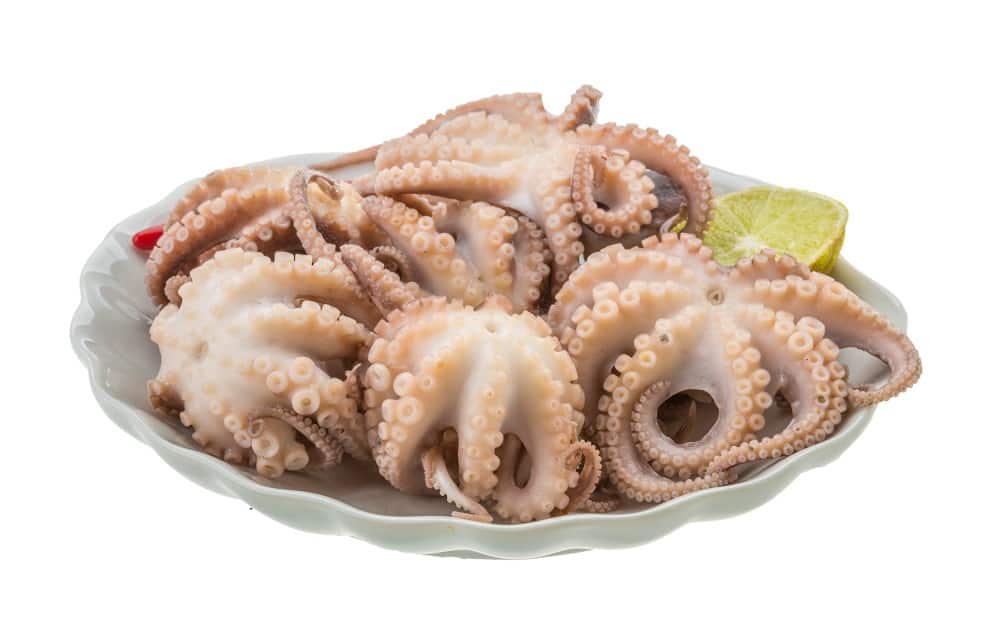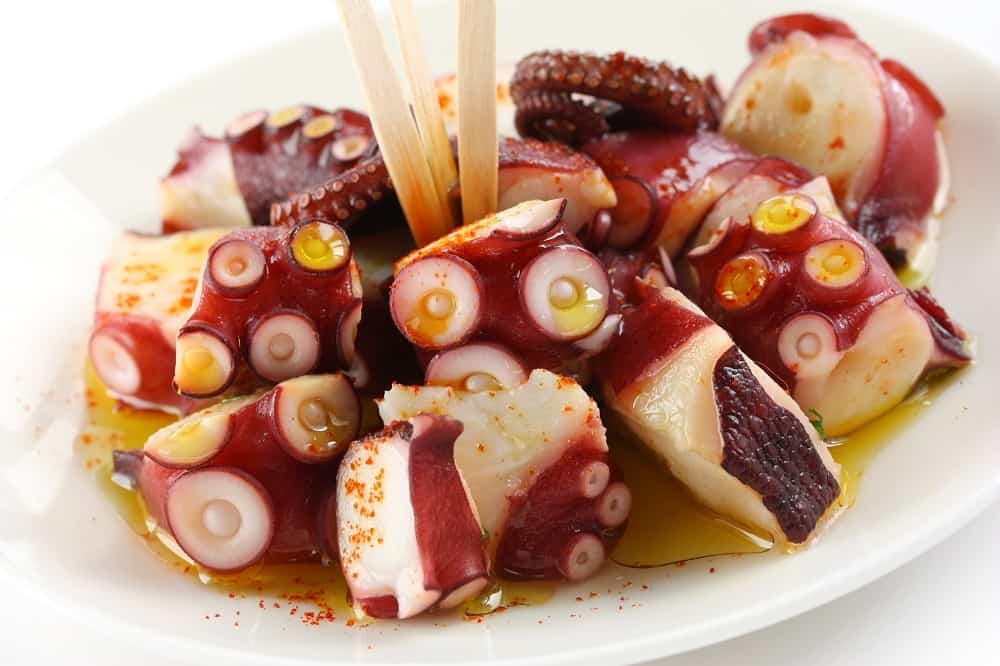Seafood is an important part of a heathy diet (Tatsuta et al., 2018). It includes all sea fish, crustaceans and cephalopods, among others, which are consumed as food by humans. Their diversity as a food group makes them confusing to classify as to their safety during pregnancy.
The octopus is classified under “shellfish” along with other mollusks in the cephalopod family. They are generally considered safe to eat during pregnancy because of their low mercury content. However, there are also risks involved in its consumption.
In this article, we will talk about the health benefits of eating seafood and cephalopods, in particular, during pregnancy. Then, we will look into some available data regarding reports of mercury content in octopus. Lastly, we will discuss how octopus can be made safer for pregnant women to eat.
Health Benefits of Seafood Consumption

Seafood is a good source of protein and essential nutrients. These include omega-3 polyunsaturated fatty acids (PUFA), selenium, iodine, and vitamin D. Among the omega-3 PUFA, docosahexaenoic acid (DHA) is most important because of their critical role in proper brain development (Tatsuta et al., 2018).
For the general population, consumption of 1 to 2 seafood meals per week have been reported to decrease the risk of congestive heart failure, coronary heart disease, ischemic stroke, and sudden cardiac death (Rimm et al., 2019).
In pregnancy, there are now numerous studies made available to evaluate seafood consumption of pregnant women and its effect on childhood neurocognitive development. In 2019, Hibbeln et al. made two systematic reviews of 44 published studies involving more than a hundred thousand mother-offspring pairs, and concluded the following:
- “Moderate and consistent evidence indicates that consumption of a wide range of amounts and types of commercially available seafood during pregnancy is associated with improved neurocognitive development of offspring as compared to eating no seafood.”
- “Overall, benefits to neurocognitive development began at the lowest amounts of seafood consumed (~4 oz per week) and continued through the highest amounts, above 12 oz per week, some range up to >100 oz per week.”
Maternal consumption of PUFA during pregnancy has, likewise, been associated with a reduced frequency of premature delivery and decreased risk of intrauterine growth restriction and pregnancy induced hypertension (Bosaeus et al., 2015). In 2017, Brantsӕter et al. reported that any amount of seafood intake during pregnancy, above no or rare consumption, was associated with lower risk of preterm births.
In 2016, Taylor et al. revealed that pregnant women who did not eat seafood were found to have an increased risk of delivering infants with low birth weights. They concluded that seafood consumption may have a protective effect on infant birth weight. Hence, their advice was to encourage continued intake of seafood during pregnancy.
Prieto et al. in 2018 investigated the relationship between seafood consumption during pregnancy and the risk of delivering a small for gestational age (SGA) infant. Over 500 pairs of pregnant women from five hospitals in Spain were included in the study. Seafood intake of at least 29 grams per day during pregnancy, which is equivalent to 2 to 3 servings per week, showed a reduction in the risk of having an SGA newborn, compared to an average seafood intake of less than 8 grams per day.
Benefits of Eating Cephalopods
The family of cephalopods include squid (and foods like calamari), cuttlefish and octopus. Around 30 species are used as food by humans. They are high in protein, minerals, trace elements, vitamin B12, DHA and eicosapentaenoic acid (EPA). However, some people find their texture undesirable for consumption (Mouritsen & Schmidt, 2020).
Cephalopods represent about 4 percent of the world’s total marine species. Octopus vulgaris, or the common octopus, is one of the most important species of octopus that are commercially harvested worldwide. Octopus vulgaris is one of the most sought-after fishery resources in southern European countries like Spain and Portugal (Oliveira et al., 2019).
In 2019, Oliveira et al. documented high levels of EPA, DHA and iodine in octopus, even after industrial water boiling. They advised consumption of 150 grams of boiled octopus to achieve significant daily intake of EPA+DHA, selenium and iodine.
Mercury Content in Octopus
Seafood may contain methylmercury and other contaminants. Therefore, it is crucial to also recognize the risks of its consumption. Seafood contains various toxic chemicals, such as methylmercury and polychlorinated biphenyls (PCB) because of bioaccumulation in the aquatic food chain (Tatsuta et al., 2018).
Mercury is known as a cumulative neurotoxin. Human exposure occurs through the diet, particularly from fish and other seafood. Increased levels of exposure to mercury can cause significant neurological and behavioral disorders, such as tremors, memory loss, neuromuscular changes, renal and thyroid disorders, and death (Taylor et al., 2016).
Human exposure to mercury occurs primarily due to consumption of seafood. Because of the ability of mercury to pass freely across the placenta, pregnant mothers and their fetus are at most risk to mercury exposure. In 2018, Tatsuta et al. reported that prenatal exposure to mercury had adverse effects with psychomotor development in infants, especially boys.
The Joint FAO/WHO Expert Committee on Food Additives recommended a provisional tolerable weekly intake (PTWI) of 4 micrograms per kilogram of mercury. Octopus vulgaris can be one source of chemical contaminants including mercury (Ariano et al, 2019).
Oliveira et al. (2019) reported 0.08 milligrams of mercury per 1 kilogram of octopus after industrial boiling. Meanwhile, Ariano et al. (2019) found only trace concentrations of mercury in samples of octopus from Italy. They concluded that consumption of octopus did not contribute significantly to the allowed level of weekly exposure to mercury.
However, Pawlaczyk et al. in 2020 demonstrated ten canned fish products that had the highest mercury content. Five of these were canned tuna, which was not surprising because tuna is a predatory fish known to contain high levels of mercury. However, also included in the list, was from the species of Octopus vulgaris.
They found that the mean mercury content in octopus was 91.5 micrograms per kilogram (Pawlaczyk et al., 2020). In Mexico, Basu et al. (2014) found that almost 40 percent of pregnant women exceeded the allowable recommended levels of mercury intake.
Despite the associated risks with increased exposure to mercury, Hibbeln et al. (2019) reported that there were no adverse neurocognitive outcomes found among the offspring of mothers with the highest ranges of seafood intake (>100 oz per week).
Can Octopus be Safely Consumed During Pregnancy?

Octopus is an excellent source of DHA and omega-3 PUFA. It is also low in fat, comparable to the fat content in lean fish. Although the manner of preparation, such as frying or cooking in butter, can add to its fat content.
According to The Master Fish Merchants’ Association of Australia, octopus has low mercury levels, along with all prawns and squids, herring, salmon and trout. These fish can be eaten as much as 2 to 3 times per week.
However, octopus should be cooked to avoid any food-borne pathogens. As a general rule, octopus should be grilled, boiled or oven cooked to ensure no viable bacterial pathogens survive.
Final Thoughts
Seafood intake has been proven to be an important addition to a healthy diet during pregnancy. Omega-3 fatty acids and DHA are especially important for the neurologic and cognitive development of babies. Therefore, it has been recommended that at least 1 to 2 servings of seafood per week should be consumed by all pregnant women.
When it comes to octopus specifically, there are limited data regarding safety of its consumption during pregnancy. Octopus is generally considered safe, as long as it is cooked thoroughly, due to its low mercury content. However, there are also concerns regarding high mercury levels, especially in canned varieties. Hence, a visit to their most trusted health care physician is warranted for all octopus-loving pregnant women.
References
- https://www.webmd.com/diet/health-benefits-octopus
- https://www.mfma.com.au/industry-issues/food-safety/mercury-seafood/
- Ariano, A., Marrone, R., Andreini, R., Smaldone, G., Velotto, S., Montagnaro, S., …, & Severino, L. (2019). Metal concentration in muscle and digestive gland of common octopus (Octopus vulgaris) from two coastal site in Southern Tyrrhenian Sea (Italy). Molecules 24(13), 2401. doi: 10.3390/molecules24132401
- Basu, N., Tutino, R., Zhang, Z., Cantonwine, D., Goodrich, J., Somers, E., …, & Rojo, M. M. (2014). Environmental Research 135, 63-69. doi: 10.1016/j.envres.2014.08.029
- Bosaeus, M., Hussain, A., Karlsson, T., Andersson, L., Hulthen, L., Svelander, C., …, & Holmang, A. (2015). A randomized longitudinal dietary intervention study during pregnancy: Effects on fish intake, phospholipids, and body composition. Nutritional Journal 14, 1. doi: 10.1186/1475-2891-14-1
- Brantsӕter, A. L., Ogge, L., Haugen, M., Birgisdottir, B. E., Knutsen, H. K., Sengpiel, V., …, & Meltzer, H. M. (2017). Maternal intake of seafood and supplementary long chain n-3 polyunsaturated fatty acids and preterm delivery. BMC Pregnancy and Childbirth 17, 41. doi: 10.1186/s12884-017-1225-8
- Hibbeln, J., Spiller, P., Brenna, J. T., Golding, J., Holub, B., Harris, W., …, & Carlson, S. (2019). Relationships between seafood consumption during pregnancy and childhood and neurocognitive development: Two systematic reviews. Prostaglandins, Leukotrienes & Essential Fatty Acids 151, 8-13. doi: 10.1016/j.plefa.2019.10.002
- Mouritsen, O., & Schmidt, C. V. (2020). A role for macroalgae and cephalopods in sustainable eating. Frontiers in Psychology 11, 1402. doi: 10.3389/fpsyg.2020.01402
- Oliveira, H., Muniz, J. A., Bandarra, N. M., Castanheira, I., Coelho, I. R., Delgado, I., …, & Goncalves, A. (2019). Effects of industrial boiling on the nutritional profile of common octopus (Octopus vulgaris). Foods 8(9), 411. doi: 10.3390/foods8090411
- Pawlaczyk, A., Przerywacz, A., Gajek, M., & Jozwik, M. I. (2020). Risk of mercury ingestion from canned fish in Poland. Molecules 25(24), 5884. doi: 10.3390/molecules25245884
- Prieto, C., Galiano, J. M., Bellido, I., Requena, R., Cavanillas, A., & Rodriguez, M. (2018). Maternal seafood intake and the risk of small for gestational age newborns: A case-control study in Spanish women. BMJ Open 8(8), e020424. doi: 10.1136/bmjopen-2017-020424
- Rimm, E., Appel, L., Chiuve, S., Djousse, L., Engler, M., Etherton, P., …, & Lichtenstein, A. (2019). Seafood long-chain n-3 polyunsaturated fatty acids and cardiovascular disease. Circulation 138(1), e35-e47. doi: 10.1161/CIR.0000000000000574
- Tatsuta, N., Nakai, K., Sakamoto, M., Murata, K., & Satoh, H. (2018). Methylmercury exposure and developmental outcomes in Tohoku study of child development at 18 months of age. Toxics 6(3), 49. doi: 10.3390/toxics6030049
- Taylor, C., Golding, J., & Emond, A. (2016). Blood mercury levels and fish consumption in pregnancy: Risks and benefits for birth outcomes in a prospective observational birth cohort. International Journal of Hygiene and Environmental Health 219(6), 513-520. doi: 10.1016/j.ijheh.2016.05.004




